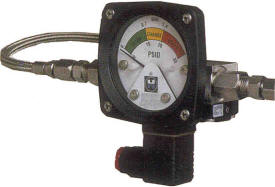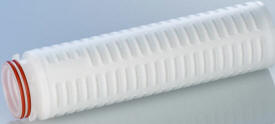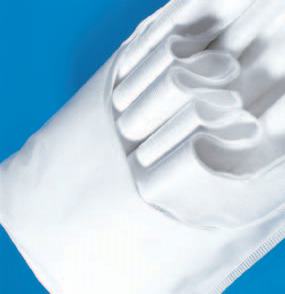Filtration Options for Gelatinous Particle Retention
Efficient filtration of deformable particles
requires special consideration of differential pressure and the medium used
for retention. This article describes the critical design criteria for
proper vessel sizing and the specialized filter elements and filter bags
designed specifically for filtration of gelatinous particles.
Examples of Gelatinous Particles
Solid-like particles
consisting of interconnected microscopic structures which are easily
deformable are generally referred to as gelatinous. Polymers, grease,
organic material, ink and paint are examples of gel-like particles which are
difficult to retain with ordinary filter mesh because the particle is easily
deformed and extruded through mesh-like structures.
 Role of
Differential Pressure
Role of
Differential Pressure
A starting differential pressure across a
clean filter element of 2 to 3 PSI is acceptable for most filtration
applications because when the element is about 75% clogged the differential
pressure will have increased to about 8-12 PSI which is when it should be
cleaned or replaced. Assuming a consistent particle load, the differential
pressure increases exponentially as the free area of the element is reduced
from particles entrained within the filter media.
Monitoring your
differential pressure is especially important for retention of gel-like
particles as they are more likely to deform and pass through your filter
media at higher differential pressures. Thus, a consequence of gelatinous
particle filtration is increased frequency of element cleaning or
replacement.
Increasing the size of the filter element will both
reduce the initial clean differential pressure across the element and
provide extra retention area to reduce the frequency of maintenance
required. The trade-off is an initially more expensive (larger) filter than
the flowrate alone necessitates for the benefit of less down time, personnel
exposure to the fluid and reduced media replacement during the years that
follow.
Types of Filters for Gelatinous Particle Filtration
-
Filter Cartridges
-
Filter Bags
-
Automatic strainers with permanent SS elements
 Filter Cartridges
Filter Cartridges
The
LOFPLEAT GG is a pleated filter cartridge made from borosilicate micro
fiberglass, a firm substrate forming a torturous path providing both depth
and surface filtration. These cartridges are about 90% efficient for
retention of particles as fine as 1 micron and support a flow rate of
approximately 1 GPM per inch length of the cartridge, which can be up to 40
inches long. High flow rate applications require a cartridge filter housing
designed to hold multiple filter cartridges.
The
LOFPLEAT HF-G is a
higher efficiency version in support of higher flow rates; approximately 8
GPM per inch length of filter cartridge with cartridge lengths up to 60” in
length.
LOFMET porous alloy filter cartridges are another example of
a rigid torturous path substrate filter cartridge suitable for deformable,
gel-like solids retention.
Filter Bags
As
compared to filter cartridges, filter bags generally have a larger surface
area and the housing design significantly reduces the chance of particle
bypass during filter media changes. While it might be possible to re-use
rigid design filter cartridges if they can be chemically cleaned, filter
bags are designed to be disposed after use due to the intricate microfiber
design which makes cleaning them almost impossible without reducing their
efficiency.
Filter bags designed to retain gelatinous particles are
made from multiple layers of meltblown polypropylene fibers to form
increasingly complex pathways through the media, thus provide very efficient
depth filtration.
 The
LOFCLEAR 500 filter bags have a pleated outer
layer to pre-filter larger particles and when the differential pressure is
low, gelatinous particles will be retained on this outer layer also. The
pleated design of the pre-filter layer equates to 32 ft2 of surface area,
about 6 times the 5.2 ft2 of surface area of the underlying #2 sized filter
bag.
The
LOFCLEAR 500 filter bags have a pleated outer
layer to pre-filter larger particles and when the differential pressure is
low, gelatinous particles will be retained on this outer layer also. The
pleated design of the pre-filter layer equates to 32 ft2 of surface area,
about 6 times the 5.2 ft2 of surface area of the underlying #2 sized filter
bag.
To increase the particle retention capacity and retain
gelatinous/deformable solids the LOFCLEAR 500 has multiple layers, each
increasingly complex to retain finer and finer particles. This torturous
pathway also entraps deformable particles as the differential pressure would
need to be quite high to extrude such particles through multiple layers of
melt-blown polypropylene fibers that are increasingly dense.
 The
LOFCLEAR 500 has a fully welded design to maintain flow path integrity as
well as ensuring the strength of the filter bag to reduce the chance of
rupture as it can hold just over 2 lbs. of particles. The outer layer
consists of a fine mesh to prevent fiber migration of the meltblown fibers
of which the filter bag is constructed. The polypropylene fibers used in the
melt blown process do not contain silicone or other crater-forming
substances and thus LOFCLEAR 500 filter bags are often used for filtration
of automotive coatings and other critical coating processes. A more thorough
description of the melt-blown design with microscopic pictures illustrating
the fiber web is online in our
filter bag materials article.
The
LOFCLEAR 500 has a fully welded design to maintain flow path integrity as
well as ensuring the strength of the filter bag to reduce the chance of
rupture as it can hold just over 2 lbs. of particles. The outer layer
consists of a fine mesh to prevent fiber migration of the meltblown fibers
of which the filter bag is constructed. The polypropylene fibers used in the
melt blown process do not contain silicone or other crater-forming
substances and thus LOFCLEAR 500 filter bags are often used for filtration
of automotive coatings and other critical coating processes. A more thorough
description of the melt-blown design with microscopic pictures illustrating
the fiber web is online in our
filter bag materials article.
Automatic Filters
Most automatic filter designs rely upon the
filtered liquid to backwash the element, which is often problematic for the
kinds of liquids containing deformable solids such as paint, ink and
lubrication fluids because the backwash volume is significant and its also
“product”. Most backwashing automatic filters involve water or other
non-hazardous fluids because sending the backwash to drain isn’t
problematic. The types of elements used in backwashing filters do not employ
a “torturous path”, rather a perforated or wedgewire structure which
deformable particles could extrude through.
 DCF style automatic
filters employ a different approach to cleaning the element. Rather than
backwashing the element, a cleaning disc cycles through the element. Often
referred to as a scraping filter, the internal disc consists of 4 spring
loaded sections to evenly distribute force across the element surface and to
account for eventual wear of the non-alloy cleaning disc. The frequency of
the cleaning stroke is user adjustable.
DCF style automatic
filters employ a different approach to cleaning the element. Rather than
backwashing the element, a cleaning disc cycles through the element. Often
referred to as a scraping filter, the internal disc consists of 4 spring
loaded sections to evenly distribute force across the element surface and to
account for eventual wear of the non-alloy cleaning disc. The frequency of
the cleaning stroke is user adjustable.
When sized to have a low
initial differential pressure and high frequency stroke, particles,
including deformable ones, have a short residence time on the surface of the
element before being swept away. The upwards and downwards force of the
cleaning disc does a great job of maintaining the low differential pressure
and the action is not so harsh against the element as to result in extrusion
of deformable particles.
The particles swept from the element reside
within the lower section of the filter body referred to as the “purge
chamber”. The shape of the purge chamber supports easy flow out of the
filter during the purge cycle. The purge cycle frequency is another
user-programmable characteristic which can be fine-tuned as needed.
The systems differential pressure purges the retained concentrated particle
slurry when its drain valve is briefly opened. When the differential
pressure is low, the cycle time or frequency of purging can be extended.
Alternately it is possible to attach a pump to the drain port to vacuum-out
the particle slurry if the differential pressure is not sufficient for
thorough purging.
Cartridge, Bag or Automatic Filter?
If your application is to remove as much gelatinous particles as possible,
filter cartridges and filter bags will work best. When the loading is very
high and its cost prohibitive to use disposable filter media, the DCF style
automatic filter is a good choice as a pre-filter, perhaps with a filter
cartridge or bag filter installed downstream to retain any remaining
particles.



